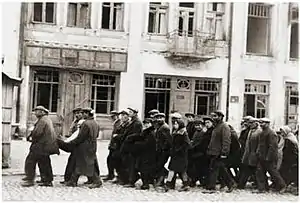Kamianets-Podilskyi massacre
The Kamianets-Podilskyi massacre was a World War II mass shooting of Jews carried out in the opening stages of Operation Barbarossa, by the German Police Battalion 320 along with Friedrich Jeckeln's Einsatzgruppen,[1] Hungarian soldiers, and the Ukrainian Auxiliary Police. The killings were conducted on August 27 and August 28, 1941, in the Soviet city of Kamianets-Podilskyi (now Ukraine), occupied by German troops in the previous month on July 11, 1941.[2] According to the Nazi German reports a total of 23,600 Jews were murdered, including 16,000 who had earlier been expelled from Hungary.[3]
| Kamianets-Podilskyi massacre | |
|---|---|
 Jews marched through Kamenets to their execution site on the outskirts of town | |
| Location | Kamianets-Podilskyi |
| Date | August 27-28,1941 |
| Perpetrators | Friedrich Jeckeln Einsatzgruppen Police Battalion 320 Ukrainian Auxiliary Police |
| Victims | 23,600 Hungarian and Ukrainian Jews |
History
The city of Kamianets-Podilskyi (Kam'yanets'-Podil's'kyy), now in south-western Ukraine, was part of the Ukrainian SSR invaded by German forces on June 22, 1941, during the opening stages of Operation Barbarossa launched from occupied Poland. Shortly after Hungary (Germany's ally) engaged in war on the Soviet Union on June 27, 1941, officials of the agency responsible for the foreign nationals living in Hungary decided to deport foreign Jews; these were mostly Polish and Russian Jews, but there were also many refugees from western Europe. Jews who could not readily establish Hungarian citizenship were equally vulnerable to deportation. As a result, many Hungarian Jews who could not document their citizenship were also deported. Many Jewish communities, especially in Governorate of Subcarpathia (then as part of Hungary), were deported in their entirety.
The Hungarians loaded the Jews into freight cars and took them to Kőrösmező (now Yasinia, Ukraine), near the prewar Hungarian-Polish border, where they were transferred across the former Soviet border and handed over to the Germans. By August 10, 1941, approximately 14,000 Jews had been deported from Hungary to German-controlled territory. Once in German hands, the Jews, often still in family units, were forced to march from Kolomyia to Kamianets-Podilskyi.
On August 27 and 28, a detachment of Einsatzgruppen (mobile killing units) in Kamianets-Podilskyi and troops under the command of the Higher SS and Police Leader for the southern region, SS General Friedrich Jeckeln, carried out mass murder of the entire Jewish community including both deportees and locals. According to Jeckeln's report, a total of 23,600 Jews were massacred in this action. It was one of the first large-scale mass murder operations in pursuit of the Final Solution in Reichskommissariat Ukraine.[4] Within the Soviet Union grounds, it was preceded by a similar killing spree which began on July 9, 1941, and continued until September 19, in the city of Zhytomyr (made Judenfrei) with three mass-murder operations conducted by German and Ukrainian police in which 10,000 Jews perished. It was followed by the killing of 28,000 Jews shot by SS and the Ukrainian paramilitary in Vinnytsia on September 22, 1941, and the September 29 massacre of 33,771 Jews at Babi Yar.[5][6]
See also
- Einsatzgruppen
- Friedrich Jeckeln
 Media related to Kamianets-Podilskyi massacre at Wikimedia Commons
Media related to Kamianets-Podilskyi massacre at Wikimedia Commons
References
- Timothy Snyder (2010). Bloodlands: Europe Between Hitler and Stalin. Basic Books. pp. 200–204. ISBN 978-0465002399.
- Martin Davis. "Kamyanets-Podilskyy" (PDF). pp. 11-14 / 24 in PDF – via direct download.
{{cite journal}}: Cite journal requires|journal=(help) Also in: Martin Davis (2010). "The Nazi Invasion of Kamenets". JewishGen. - Randolph L. Braham (2000). The Politics of Genocide. Wayne State University Press. p. 34. ISBN 0814326919.
- Mallmann, Klaus-Michael (2001). Der qualitative Sprung im Vernichtungsprozeß: das Massaker von Kamenez-Podolsk Ende August 1941 [The jump in quality of the extermination process: the Kamianets-Podilskyi massacre, end of August 1941]. pp. 239–264. ISBN 3-593-36722-X.
{{cite book}}:|journal=ignored (help) - Yad Vashem (2016). "Goering orders Heydrich to prepare the plan for the Final Solution of the Jewish Problem". The Holocaust Timeline 1940-1945. The Holocaust Martyrs' and Heroes' Remembrance Authority. Archived from the original on July 15, 2018. Retrieved January 20, 2017.
- Desbois, Patrick (2009). "Places of Massacres by German Task Forces between 1941 - 1943" (PDF). Germany: TOS Gemeinde Tübingen. Archived from the original (PDF) on October 9, 2016. Retrieved January 20, 2017.
Further reading
- Eisen, George (2022). A Summer of Mass Murder: 1941 Rehearsal for the Hungarian Holocaust. Purdue University Press. ISBN 978-1-61249-777-8.
- This article incorporates text from the United States Holocaust Memorial Museum, and has been released under the GFDL.